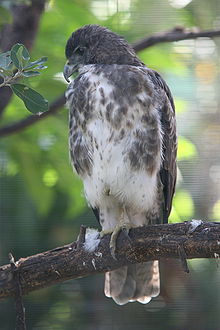Hawaiian hawk
| Hawaiian hawk | |
|---|---|

| |
| At Honolulu Zoo, Hawaii | |
| Scientific classification | |
| Domain: | Eukaryota |
| Kingdom: | Animalia |
| Phylum: | Chordata |
| Class: | Aves |
| Order: | Accipitriformes |
| Family: | Accipitridae |
| Genus: | Buteo |
| Species: | B. solitarius
|
| Binomial name | |
| Buteo solitarius Peale, 1849
| |
The Hawaiian hawk or ʻio (Buteo solitarius) is a
Description
The Hawaiian hawk measures approximately 40 to 46 centimetres (16 to 18 in) in length. The female, which weighs 605 g (21.3 oz) on average, is larger than the male, which averages 441 g (15.6 oz).[5] Two color phases exist: a dark phase (dark brown head, breast, and underwings), and a light color phase (dark head, light breast and light underwings). Feet and legs are yellowish in adults and greenish in juveniles. During breeding season one of the pair, possibly the female, has a distinctive yellow forecap area just above the upper mandible.
Threats
Common threats to the ʻio are illegal shootings, the degradation of their native forest habitat, poisoning, vehicle collisions, starvation, and predation from other animals.
Lifestyle
This solitary hawk remains in and defends its territories year round. They nest from March through September, and usually lay only one
The ʻio usually hunts from a stationary position, but can also dive on prey from the air. Due to Hawaii having almost no native land
In Hawaiian culture
The Hawaiian hawk was one of many birds unleashed in the third period of creation (wā) mentioned in the
References
- ^ . Retrieved 12 November 2021.
- ^ a b "Buteo solitarius. NatureServe Explorer 2.0". explorer.natureserve.org. Retrieved 24 April 2023.
- ^ "ʻIo" (PDF). Hawaii’s Comprehensive Wildlife Conservation Strategy. State of Hawaiʻi. 2005-10-01. Retrieved 2009-03-20.
- ^ "Newsroom | U.S. Fish & Wildlife Service".
- ^ "Archived copy" (PDF). Archived from the original (PDF) on 2010-07-06. Retrieved 2012-05-21.
{{cite web}}: CS1 maint: archived copy as title (link) - ISBN 0-8248-0771-5.
- "Hawaiian Hawk / Buteo solitarius / ʻIo". Fish and Wildlife Pacific Office. United States Fish and Wildlife Service.


